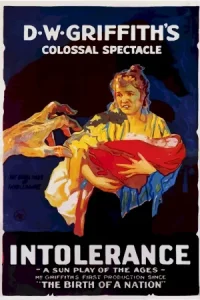A Century Ahead: How D.W. Griffith's 'Intolerance' (1916) Shook Cinema's Foundations with Epic Grandeur!
In the tumultuous, formative years of motion pictures, when the very language of cinema was still being invented, one visionary filmmaker stood as a colossus, pushing the boundaries of what film could achieve: D.W. Griffith. Having revolutionized narrative structure and cinematic grammar with his controversial masterpiece The Birth of a Nation (1915), Griffith, stung by accusations of racism, embarked on an even more ambitious, gargantuan project: Intolerance (1916). This wasn't merely a film; it was an epic, a grand operatic statement, designed to be the ultimate rebuttal to bigotry and a plea for universal understanding. Its groundbreaking scale, unprecedented narrative complexity, and audacious editing techniques — particularly the use of parallel storytelling across millennia — were utterly revolutionary. Intolerance didn't just expand cinematic scope; it exploded it, proving film's capacity for complex social commentary and establishing a new benchmark for epic spectacle that would influence filmmakers for generations, from Eisenstein to Scorsese.
Intolerance famously interweaves four distinct storylines, each set in a different historical period, all united by the overarching theme of intolerance and injustice through the ages. We witness the fall of ancient Babylon, brought down by religious fanaticism and internal corruption; the Passion of Christ, illustrating the condemnation of an innocent man; the St. Bartholomew's Day Massacre, depicting sectarian violence in Renaissance France; and a modern American story, where poverty, crime, and puritanical judgment unjustly persecute a young couple. Griffith's audacity lies in his decision to cross-cut between these seemingly disparate narratives, building to a thrilling, climactic montage where all four stories reach their peak of suffering and injustice. This innovative narrative structure, while initially bewildering to audiences accustomed to linear storytelling, was a bold experiment in cinematic rhetoric, creating a powerful, overarching commentary on humanity's cyclical failings.
D.W. Griffith's direction in Intolerance is a staggering feat of cinematic ambition and technical wizardry. The film boasts colossal sets, most famously the gargantuan walls of Babylon, which were the largest ever constructed for a film at the time and required thousands of extras. His use of deep focus, panoramic crane shots (achieved with innovative camera rigs), and incredibly detailed crowd scenes created a visual grandeur that was unparalleled. Beyond the spectacle, Griffith's editing, particularly his pioneering use of parallel editing to draw thematic connections across vastly different time periods, was revolutionary. He essentially created the concept of "montage" as a tool for intellectual and emotional impact, manipulating time and space to create a powerful, unified message. The film's sheer scale, combined with its innovative techniques, makes it a masterclass in early cinematic artistry.
Despite its immense artistic and technical achievements, Intolerance was a catastrophic box office failure, partly due to its length, complex structure, and the public's reluctance to embrace its overtly moralizing tone after the controversy of The Birth of a Nation. However, its critical and historical significance cannot be overstated. The film featured a sprawling cast including Lillian Gish (as the Woman Who Rocks the Cradle), Mae Marsh (as The Dear One in the modern story), Constance Talmadge (as the Mountain Girl in Babylon), and Robert Harron. Griffith poured his personal fortune into the production, and its financial failure nearly ruined him. Despite this, Intolerance remains a towering landmark in film history, influencing countless filmmakers with its epic scope and revolutionary editing. It's a challenging, occasionally unwieldy, but ultimately awe-inspiring cinematic experience that continues to reveal the genius of a true pioneer.
Director: D.W. Griffith.
Cast: Lillian Gish as the Woman Who Rocks the Cradle (narrative device), Mae Marsh as The Dear One (Modern Story), Constance Talmadge as The Mountain Girl (Babylonian Story), Robert Harron as The Boy (Modern Story), Alfred Paget as Belshazzar (Babylonian Story).
Special Info/Trivia: Intolerance was a direct response to the criticism Griffith received for the perceived racism of The Birth of a Nation. It features four interconnected storylines from different historical periods (Babylonian, Judean, French Renaissance, and Modern American). The Babylonian set was one of the largest ever built for a film at the time. The film was a major box office flop, contributing to Griffith's financial difficulties. Its pioneering use of parallel editing and montage had a profound influence on later filmmakers, particularly Soviet montage theorists. Its original length was rumored to be much longer than the released version.

